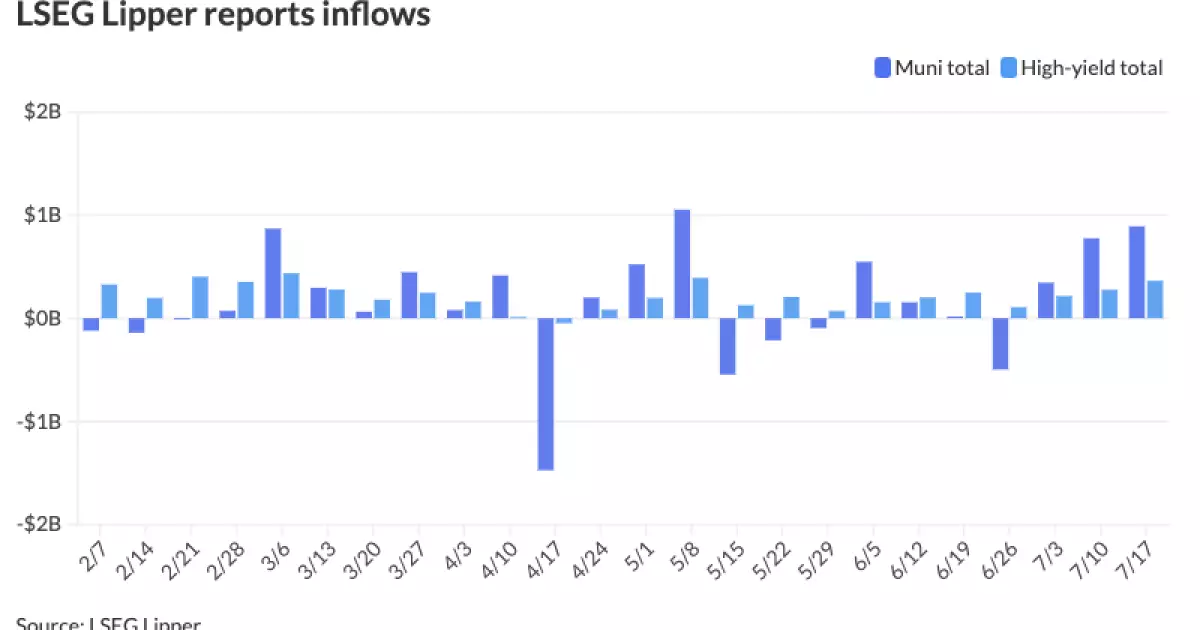The municipal bond market has displayed varying trends recently, marked by slight firming in short-term municipal bonds as we head into mid-July. While the primary market decelerates, muni mutual funds are experiencing continued inflows, a sign that investor sentiment remains resilient. According to the latest data from Refinitiv Municipal Market Data, yields for U.S. Treasuries have risen, creating a contrasting backdrop against the stability of municipal bonds. Investors seem to be navigating the complex interplay between rising Treasury yields and the relatively stable yields offered by municipal bonds, leading to strategic inflows into this segment.
The muni-to-Treasury yield ratios are critical here: the two-year ratio stands at 64%, three-year at 66%, five-year at 68%, 10-year at 67%, and the 30-year at a robust 83%. These figures indicate that while Treasuries are becoming more attractive, the perceived safety and tax advantages of municipal bonds still retain their appeal for many investors.
Inflows into municipal bond mutual funds have been substantial, totaling approximately $891.4 million in the latest week—up from the previous week’s $775.3 million. This continued trend is reinforced by inflows in the high-yield segment, which garnered an impressive $364.4 million, compared to $276.4 million the week prior. Such figures underscore a notable eagerness among investors to engage with the municipal bond market, despite the rising yield environment for U.S. Treasuries.
Notably, GW&K Investment Management analysts have observed an “improved significantly” outlook for municipal bonds throughout the second quarter. They attribute this optimism to stabilizing yields and a decrease from previously ultra-tight relative value ratios, allowing for a more favorable cushion against fluctuations in Treasury prices. Their perspective reflects an understanding of underlying credit fundamentals, which remain resilient even amid economic headwinds, bolstered by conservative budgeting and unprecedented reserve levels at the municipal level.
July is anticipated to be a peak month for municipal bond performance, a sentiment echoed by various analysts, including those at BlackRock. Their assertion that traditional seasonal dynamics—like heightened reinvestment flows and tapering issuance—signal a favorable environment for returns is particularly compelling. However, analysts caution that while certain performance gains may have been accrued in June, multiple factors continue to suggest sustained strength, including attractive yield levels, stable interest rates, and an influx of deals aligning with the historically favorable summer period.
As market participants navigate these waters, it is noteworthy that concerns are present regarding the volume of new issuances seen in 2024. Craig Brandon from Morgan Stanley observed that while high-quality issuances are plentiful, they correspond with flat market indices year-to-date— an indicator of supply-demand imbalances that can occasionally challenge market momentum.
The issuance landscape reflects a busy calendar ahead, particularly with significant offerings poised to hit the market over the next few weeks. Notable transactions, such as the San Francisco Public Utilities wastewater revenue bonds worth $624.615 million, and green bonds from the Metropolitan Transportation Authority and Santa Clara County, are among the critical elements that could influence market dynamics in the near future.
The liquidity in the municipal market seems ripe for additional investments, particularly with larger deals like the expected $1.7 billion from the Texas Transportation Commission and $1.2 billion of GO refunding bonds from New York City. As these opportunities unfold, market participants should remain cognizant of broader economic signals and the potential for volatility driven by upcoming elections.
Despite the prevailing optimism, several strategists—including those at GW&K—advise a cautious approach as certain indicators suggest volatility may be on the horizon. Factors like the notable flattening of the yield curve could reduce the potential for further significant gains, while upcoming electoral developments could inject uncertainty into the markets. As the Federal Reserve prepares to reconsider its stance on monetary policy, market participants must remain vigilant as shifts in investor sentiment could trigger reevaluations of risk—especially concerning duration.
With the backdrop of mixed yield curves and fluctuating Treasury performance, it remains imperative that investors refine their strategies and assessments surrounding municipal bonds. Overall, while the path ahead appears promising, it is marked by complexity that requires careful navigation and responsive investment strategies.

